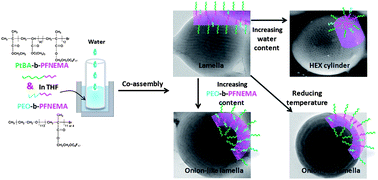Co-assembly of poly(tert-butylacrylate)-b-poly(2-[(perfluorononenyl) oxy] ethyl methacrylate) (PtBA-b-PFNEMA, FA) and poly(ethyleneoxide)-b-poly(2-[(perfluorononenyl) oxy] ethyl methacrylate) (PEO-b-PFNEMAs, FB) were carried out to construct binary blend polymeric particles with diverse microphase structures through fluorophilic interaction. Successful control of the phase behavior relies on the location of FB within a nanoscale particle. Due to the fluorophilic interaction, FB is located at the interface between PtBA and PFNEMA or partly dissolved in the PFNEMA phase rather than forming an individual microdomain. By changing the composition of the binary blend particles, the water content, and preparation temperature and the fluorophilic interaction could be tuned and hence the location of FB could be influenced. Order–order phase transition and transformation from most stable onion-like lamellar structures to stacked lamellar structures and cylindrical structures were achieved utilizing PEO113-b-PFNEMA11 (FB1). In addition, the relatively shorter PFNEMA chain and larger dispersity (Đ) of PEO113-b-PFNEMA4 (FB2) resulted in the ubiquitously coexistence of ordered lamellar and gyroid microdomains in the same particles. These transitional structures, which were successfully obtained by both SEM and TEM, would be very useful for the investigation of the phase transition path. The introduction of fluorophilic interactions into the dynamic self-organized precipitation (D-SORP) method sustained the delicate control of the phase behavior in polymeric particles.
